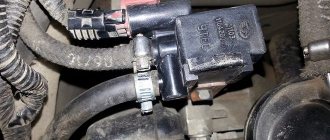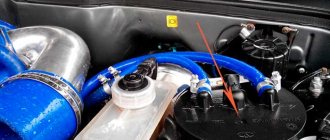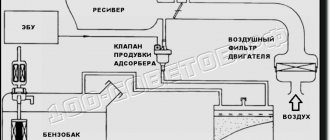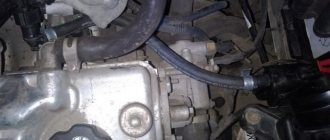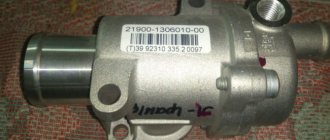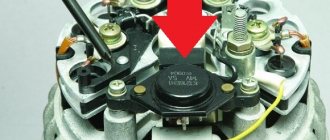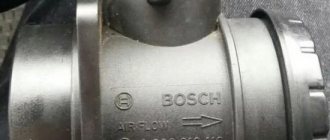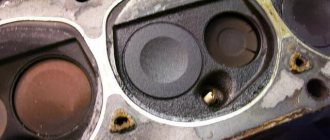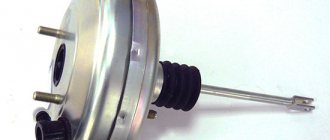Gravity ball valve for heating. Why and where to put it?
In a gravity heating system, the section of the return pipe in front of the boiler branches into parallel sections.
In one section a circulation pump is installed, and in the second section a gravity valve is installed. Gravity valve for heating - where and why to install it?
In order to understand where and in what heating system a gravity valve is installed, we first consider existing heating systems.
For the efficient operation of any heating systems, circulation of coolant (water) throughout the system is necessary.
According to the circulation method, heating systems can be divided into the following types:
1. Heating system with natural circulation;
2. Heating system with forced circulation;
3. Combined heating system that can operate in these two modes.
Heating system with natural circulation. This system works thanks to the law of attraction of the earth, gravity, which is why it is often called gravitational. When water is heated in the heating system, due to a decrease in density, it becomes lighter and therefore rises upward in the heating system. As it cools (heat is released), the density of the water increases, it becomes heavier and therefore begins to flow downward. The design of the gravity heating system is created in such a way that after the boiler, the coolant is supplied as high as possible in the heated room, and then, due to the slopes, it can naturally flow down and thus naturally circulate.
Heating system with forced circulation. In this heating system, a small pump (about 100 W) is installed on the return supply pipe, which forcibly allows the coolant to circulate through the system. Forced circulation increases the efficiency of the heating system due to greater coolant (water) output. In such a system, the design of the heating system is less demanding regarding the location of the height of the boiler to the radiators. This system is recommended for use where power outages are possible.
Therefore, the combined system, in the presence of voltage and a working pump, operates as a forced circulation system, and when the electricity is turned off, it automatically switches and starts working in a natural circulation system.
So, the main element of pipeline fittings, which is responsible for automatically switching from forced circulation to natural circulation, is a gravity heating valve.
The gravity valve in the heating system works as follows (see diagram).
In a gravity heating system, the section of the return pipe in front of the boiler branches into parallel sections. In one section a circulation pump is installed, and in the second section a gravity valve is installed. When there is voltage in the network and the circulation pump is operating, creating forced circulation, the gravity valve is in the “Closed” , and when the voltage in the electrical network is lost, the valve automatically switches to the “Open” and switches the heating system to natural circulation mode.
You can buy cast iron gravity ball valves for heating in Minsk from the Laboratory of Heat company by going to the company’s website (online store) on the page Accessories and Accessories Check valves or by visiting the company’s representative office at the address: Minsk, st. Slobodskaya, 2, office 15
Source
Automotive gasoline vapor trap: adsorber and its purpose
You should immediately understand the question of what an adsorber is and why it is needed on a car. Initially, it is worth noting that the correct name of this device is an adsorber, that is, it is written with the letter “d,” although many call it an absorber, which is not entirely correct. The difference between an adsorber and an absorber is that the first one accumulates vapors (in this case, gasoline) and holds them, while the second one completely absorbs the substance (that is, with the impossibility of their subsequent release).
We will find out why cars use an adsorber and not an absorber after understanding the purpose of this device.
A gasoline vapor collector is a kind of filter that prevents direct contact of gasoline with the atmosphere, which reduces the level of pollution. Such devices were invented after the introduction of the Euro-2 environmental standard, which prohibits atmospheric pollution with gasoline vapors.
The main purpose of the device is to temporarily absorb the vapors that form in the gas tank and use them for selfish purposes, that is, not just suppress, but transport them to the engine, where they will be supplied to the cylinders for combustion along with the fuel assembly.
Returning to the name of the device, we can safely say that the Priora and other modern cars use an adsorber that only temporarily accumulates gasoline vapor (which occurs while the engine is not running). The use of absorbers would not allow vapors to be directed into the combustion chambers of the engine due to their complete absorption by the sorbent.
Design and general diagram of the EVAP gasoline vapor recovery system
The design and operating principle of the device in question is quite simple. Below is a diagram.
To understand this, you need to know that the system consists of a number of the following parts:
- The separator is needed to capture gasoline vapors and then return it in liquid form back to the tank. On Priora it is located in the left rear wheel niche. It is important not to confuse it with an adsorber. The separator (top) has a built-in gravity valve.
- The gravity valve is needed to eliminate the possibility of fuel leaking from the tank if the vehicle rolls over in the event of an accident. It is also called a safety or safety valve, which is triggered when the vertical deviates by an angle of more than 90 degrees.
- The pressure relief valve is a device that eliminates the possibility of deformation of the metal tank when gasoline is used up. To put it simply, as fuel is consumed, a vacuum forms inside the sealed tank, which can cause deformation of its walls. To prevent this, a pressure sensor is used, which is also called a breather. With its help, the pressure inside the tank is equalized with atmospheric pressure. Its role is played by the atmospheric channel on the adsorber. When a vacuum is created in the tank, air is sucked in through the air channel, thereby equalizing the pressure in the tank. If the channel is faulty (contaminated), then the risk of tank deformation increases. That is why the Priora uses a gas tank cap with a valve for air intake as a safety net. This valve does not release air from the tank, but lets it in to stabilize the pressure.
- Absorbent - as mentioned above, it is activated carbon that temporarily absorbs and retains gasoline vapors that enter the engine during purging.
- The filter prevents the possibility of activated carbon granules entering the purge valve, as well as contaminants entering the adsorber through the air channel.
- Electromagnetic valve (canister purge valve)—its role in the system is key, since it is responsible for opening the channel for sucking gasoline vapors from the canister.
- Connecting tubes - needed to connect the adsorber to the gas tank, separator and other structural elements.
Diagram of the fuel vapor recovery system on Priora: design and designation of the main elements
The diagram of the gasoline vapor recovery system on Priora is as follows:
In the diagram, each element has a corresponding name and purpose. The name of each item is listed in the description below:
The purpose of each element of the system is described in detail in the material below.
see also
- Selecting a fan for ventilation
Breezer supply ventilation- Kitchen with ventilation box in the corner design
- Ventilation and heating center
- Ventilation blows in the opposite direction
- Design of a ventilation system for an apartment in an apartment building
- Electric motor for ventilation
- Ventilation without heat loss
- Dimmer for ventilation
- Safety goggles with indirect ventilation
- An anemometer is a device for measuring ventilation performance
How does a car's gasoline vapor recovery system (adsorber) work?
The principle of its operation on Priora is identical to other brands of cars, so let’s look at the overall picture.
- Gasoline has the property of releasing vapors, which usually accumulate in the upper part of the filler neck of the tank. For this, a separator is used, with the help of which these vapors are condensed and returned in liquid form back to the tank.
- Some vapors do not condense in the separator, so an adsorber is provided for this. In it, vapors accumulate and are retained (this happens when the car engine is turned off).
- After starting the engine, reaching operating temperature, and only with the throttle valve open (this is very important), the solenoid valve opens. When it is triggered, for which the ECU is responsible, gasoline vapor is supplied from the adsorber to the throttle assembly. This process is called purging. Its duration is controlled by the ECU.
- The process occurs as follows: the adsorber has a channel connecting it to the environment. As soon as the solenoid valve opens, the engine sucks in air, which, together with gasoline vapor from the adsorber, enters the throttle assembly.
- From the throttle, these vapors, along with the air, enter the intake manifold, where they are mixed with a portion of gasoline released from the injectors and are sucked into the combustion chambers of the cylinders. As a result, they are burned, thereby increasing the efficiency of the internal combustion engine.
The operating principle of the system is quite simple and reliable, but malfunctions occur, which leads to problems with engine operation. What are the signs of a malfunction of the adsorber and its valve on a Priora, and how to determine the failure of parts of this system, we will consider further.
What elements make sense to repair?
Repair of most parts is not provided.
- Cracked, damaged or clogged fuel lines must be replaced immediately.
- It is impossible to clean dirty fine filters or adsorber. They just need to be changed.
- A clogged coarse filter can be easily cleaned if necessary. It only needs to be changed if the mesh is damaged.
- In some cases, it makes sense to repair the gas tank. Holes that appear as a result of physical impact can be soldered or welded. However, you must follow safety rules. Otherwise, an explosion of gasoline vapors accumulated in the tank is possible.
- There is no point in soldering or cooking a rusted gas tank. As a rule, there will probably be several pockets of corrosion in it. Once you solder one hole, you'll soon find new ones.
- The fuel level sensor and fuel pump also cannot be repaired. The only exception is bad contacts at the connection terminal. In this case, it will be enough to remove the corrosion or contamination to revive the device.
- Repairing injectors involves cleaning the jets. This requires dismantling the parts and washing them with a special cleaner. Similarly, it is possible to restore the performance of the throttle. If washing does not help, the parts need to be replaced with new ones.
- A broken pressure regulator is easier and cheaper to replace than to try to repair.
In most cases, repairs come down to localizing the fault and replacing failed parts.
Malfunction of the adsorber and adsorber valve on a Priora: main symptoms
The fundamental element of the entire system is the solenoid valve, which is controlled by the ECU. It is because of the failure of this element that problems arise on the car. However, let’s look at the main signs of a malfunction of the gasoline vapor recovery system:
- Floating speed. Naturally, there is no need to rush to diagnose the system, since this phenomenon is often associated with a number of other problems, but it should not be ruled out either. Why do the revs fluctuate? The cause is a solenoid valve that may be stuck open. As a result, it turns out that air is sucked into the throttle assembly when starting the engine, which ultimately leads to the appearance of the effect of changing crankshaft speeds. Prior owners often encounter this problem, so it is important to pay attention to the serviceability of the solenoid valve. You will find out where it is located on Priora and how to check it in the sections below.
- The engine does not gain full power, which is quite understandable; an element of the fuel vapor recovery system is faulty. As a rule, this can be caused by clogged adsorber, which reduces throughput.
- The engine stalls at idle when trying to add gas.
- Fuel indication sensor readings are incorrect. It shows either a full tank or an empty one. This usually happens when the pressure relief valve does not cope with its function. The possibility of failure of the gas tank cap, which has a built-in breather, cannot be ruled out.
- Increased fuel consumption.
- When you unscrew the cap from the neck of the tank, a long hissing sound occurs, indicating that the pressure valve is not coping with the task (the pressure is not equalized). If hissing does not occur at all when unscrewing the lid, then this may also be a sign of a malfunction of the breather in the lid, since depressurization of the product is appropriate.
These signs indicate that there is a malfunction in the gasoline vapor recovery system on the Priora. In addition, if the solenoid valve (purge) fails, the Check Engine may light up on the instrument panel, and the corresponding error codes will be displayed on the on-board computer:
- P0441 - incorrect air flow through the adsorber valve;
- P0442 - leak in the gasoline vapor recovery system;
- P0443 - malfunction of the valve circuit of the gasoline vapor recovery system;
- P0444 - break in the canister valve wire;
- P0445 - the control circuit for the canister purge valve closes to ground;
- P0446 - malfunction of the control circuit of the vapor valve for collecting gasoline vapors EVAP (Evaporative Emission Control System Vent Control Circuit Malfunction).
If one of the errors listed above is displayed on the BC, then you need to look for a malfunction in the gasoline vapor recovery system. Typically, this error can be associated with a failed solenoid valve, a clogged filter element, or a faulty pressure relief valve.
Determining possible damage
see also
We have figured out why the adsorber is needed, now let’s determine the signs indicating its failure. Considering the quality of fuel at gas stations in our homeland, this part often becomes dirty and fails.
Any malfunction of this mechanism can be easily determined by obvious signs:
- Damage to the absorber - the fact that this mechanism of your car has problems can be determined by hearing a hissing sound when opening the tank, it indicates the accumulation of an excess amount of gasoline vapor.
Excessive pressure appears in the tank when you open the lid, there is a moment when the contact area with the external environment is small, and the pressure is quickly “relieved” through it, and the tank “hisses”, similar to a bottle of soda.
If the problem is not “treated”, the tank will shoot off the lid at some point, in addition to repairing the tank, this promises serious liability problems (possibly criminal), because it is impossible to predict where the lid will fly, the speed of which is comparable to the speed of a cannonball.
- Valve failure - this will be recalled by instability of the engine at idle speed, the car will begin to randomly increase (lower) the speed itself and stall.
In the event of a breakdown, the adsorber is often removed completely, we will discuss how to do this below, but there are no unnecessary parts in the car, it is worth remembering. If you don’t want to remove and gut the ECU, you can try to fix everything yourself. The weakest point in the absorption kit is the VAZ 2114 valve.
On the VAZ 2115, a decrease in speed was noticed while driving, the car choked and stalled while driving, after the car stood, the problem temporarily disappeared.
Before repairing, you need to make sure that the problem is here:
- Use a flat-head screwdriver to unscrew the fastener on the motor cover (be careful, the fastener is plastic, you shouldn’t break it), and then very carefully remove the clamps.
- We remove the part and blow out the valve. If air does not pass through, then the valve is operational, and the breakdown is elsewhere; if air passes through the valve, then you have found the problem.
A valve failure, in addition to unstable idle speed, will soon give you CheckEngine and significantly increased consumption.
Causes of malfunction of the adsorber on Priora and features of its self-check
The adsorber contains activated carbon in granular form, which gets wet over time, which reduces the level of air permeability. Typically, such a malfunction is accompanied by error on BC P0441. However, in addition, a more common problem is when coal particles enter the body of the solenoid valve and, accumulating in large quantities, do not allow it to close, which leads to the problem of floating speed on Priora.
The causes of adsorber malfunction are the following factors:
- Depressurization of the adsorber housing. Usually occurs in case of mechanical damage. If such a breakdown occurs, the part must be replaced.
- Damage to the integrity of the power supply wires of the solenoid valve. In this case, errors P0443/P0444/P0445 and P0446 are displayed. This could be an open circuit, short to ground, or low voltage.
- Air inlet fitting and filter element are dirty. Air enters the device through the inlet fitting, as a result of which accumulated vapors are purged. Through the fitting, contaminants enter the adsorber, which leads to a decrease in the level of air permeability. This causes the device to operate ineffectively.
To determine the cause of the malfunction, you will need to focus on the corresponding errors or symptoms. For example, if there is a suspicion of a violation of the seal of the housing, then it is necessary to remove the adsorber and inspect its condition. If no defects are found, then its tightness is usually checked as follows:
- the connections to the atmosphere and to the solenoid valve are plugged;
- compressed air is supplied to the remaining fitting connecting the device to the gas tank;
- the absence of signs of air leakage indicates the integrity of the adsorber housing.
Be sure to inspect the integrity of the power wires of the solenoid valve, and if necessary, call them. If there is a suspicion that the valve is jammed in the open position, then a simple and reliable way to check is to start the engine and plug the fitting connecting the adsorber to the atmosphere with your hand. If after this the engine operation changes, then the cause of the malfunction has been identified, and all that remains is to eliminate it by replacing the part.
Where is the adsorber located on Priora and how to replace it
It should be emphasized once again that often the cause of a malfunction of the fuel vapor recovery system is the solenoid valve, so troubleshooting should begin with it. If this part on the Priora is working properly, then there is a high probability that the adsorber has failed. To replace it, you must first understand the location. Typically such devices are located next to the gas tank, but not always. On a Priora, the adsorber is located in the engine compartment. You need to look for it next to the generator under the right headlight. The photo below shows the location of the adsorber on a Priora with air conditioning.
It is important to note the fact that the Priora can have an adsorber, both rectangular and round.
Despite the differences in shape, the products are completely interchangeable.
The photo below shows the location of the element on the radiator side.
Now let's figure out how the adsorber is removed on a Priora. The process will be slightly different depending on the vehicle configuration. If the Priora is 8-valve and without air conditioning, then the process of removing the adsorber is as follows
:
- Initially, you should disconnect the hose fastenings “3” and “4” in the figure below. To do this, press the latches and pull the hoses.
- Using a wrench at “8”/“10” (may differ), unscrew the fastening bolts (2 pcs.). For unscrewing, it is recommended to use a spanner wrench with a ratchet, since they are the most convenient for unscrewing fasteners in hard-to-reach places.
- After this, you can remove the part. There is enough space to remove it, and you do not need to remove the generator or headlight to do this.
- Check for serviceability or replace. Installation is carried out in the reverse order of removal. When installing, it is important to observe the tightening torque of the mounting bolts. They are tightened with a force of 1.6-2.8 Nm.
However, the process of dismantling the gasoline vapor trap is not difficult on a Priora without air conditioning, where there is free access to the device. On 16-valve VAZ-2170 models with Halla and Panasonik air conditioners, the process will be slightly different. The difference is that you need to remove the right headlight, under which the adsorber is located. The principle of dismantling the adsorber is to perform the following actions:
- First you need to remove the top trim from the headlight by unscrewing the four fasteners using a Phillips screwdriver.
- Disconnect the power supply from the headlight from the inside using a screwdriver.
- After this, you need to loosen the bumper (right side).
- This is necessary in order to gain access to the mounting bolt, which is located under the headlight. We unscrew it.
- Unscrew the Phillips screwdriver located on the side.
- The headlight is secured with three fasteners. The third bolt is at the top. After unscrewing it, you can remove the headlight to gain access to the adsorber for subsequent removal.
Having gained access to the adsorber, disconnect the hoses from the device and unscrew the two fastening screws. We remove the device, check it or change it.
Assembly is performed in the reverse order of dismantling. The example of removing the generator shows how to get to the adsorber on a Priora with air conditioning.
This completes the procedure for replacing the adsorber on a Priora with and without air conditioning. Despite the laboriousness of the process, everything is done very quickly and without the need to visit a car service center.
Adsorber - what is it? Visual characteristics
The word “adsorber” itself translated from English means “to absorb”, “to absorb”. By its design, this part is an energy-absorbing plate. Externally, you may not immediately be able to tell that the bumper is not solid - inside it there is a special filler made of polymer materials.
This part of the device (bumper) is considered the main one and converts mechanical energy into thermal energy, which is then dissipated in the external environment. The plate located in the adsorber bears a lot of responsibility, which is why many manufacturers place such stringent requirements on its technical characteristics and the properties of the entire device as a whole.
But the safety and health of people depends not only on this. In order for the adsorber to perform its functions efficiently on a VAZ Kalina car, it is necessary to reduce the risk of damage to the rear bumper to zero. This part is a power element, and it is it that “bears the blow” that can cause mechanical damage. And if the device is broken or punctured, it can no longer be allowed to be used. This is because with each blow the adsorber (including the 2110 VAZ) loses its ability to absorb emissions.
Instructions for checking and replacing the adsorber valve on a Priora: where it is located, cleaning, article number
A headache on VAZ cars is the solenoid valve or the adsorber purge valve. Let's look at this device in more detail. First, let's find out where it is located on Priora. The photo below shows the location of the canister purge valve on a Priora.
It is located near the right “glass”. The material repeatedly mentioned why the canister purge valve on a car is needed and what function it performs. Below is another reminder of what the part is for.
First, let's understand the principle of operation of the valve. The electrical diagram of the canister purge valve on the Priora along with the pinout will help with this.
The device is a valve that is controlled by electrical impulses. To do this, the design of the device has a winding, which, when power is applied, retracts the metal core, which leads to the opening of a channel through which air passes from the adsorber to the throttle assembly. The part is non-separable and non-repairable, therefore, if there are signs of malfunction, it should be replaced. Below in the photo is the canister purge valve (from Kalina) in cut form.
The device receives two contacts: one from the relay (plus), and the second control from the ECU (ground). The valve opens when a voltage pulse is supplied from the ECU. The operating principle of this device is simple. However, despite this, on all VAZ cars, the canister purge valve is a common cause of floating speed, a decrease in engine power and an increase in fuel consumption. This happens due to the fact that activated carbon granules from the adsorber get into the channel with the valve, which ultimately leads to the device jamming in the open position. After starting the engine, the valve should be closed, but since it jams, it remains open, so air leaks into the throttle assembly at idle.
To check the functionality of the solenoid valve, you need to perform the following steps:
- First you need to remove the device from the car. To do this, you need to disconnect the power supply and loosen the clamps (if any) that secure the hoses. After this, remove the part by pressing the latch and pulling it up. Often the latch fails, so you can use a plastic clamp.
- Carry out an inspection. After inspection, you can draw conclusions about the serviceability of the product, as evidenced by the photo below.
- Now let's proceed to the actual verification. Using a bulb, syringe or compressor, we supply air into one of the channels. Air should not escape from the second, since when the power is turned off, the valve closes. If it is blown through, then there is a high probability of it getting stuck in the open position.
- Another way to check is to apply 12V power to the contacts of the device. In this case, a characteristic click will be heard, indicating that the valve has been activated (its opening). We stop the power supply, and at the same time it should click again, which indicates that it is closed and serviceable.
- Don't forget to make sure that the valve is receiving power. To do this, we measure it in the chip using a multimeter. The voltage should be 12V. Contact “A” is positive, and “B” is “ground” from the ECU.
The verification procedure is not at all complicated and takes about 10 minutes. Based on the results, a decision is made about the need to replace the valve. If it is not working, then it must be replaced. We buy a new device, which has the code 21103-1164200-02/21103-1164200-03 (the products are interchangeable).
Knock in the transfer case of the new Chevrolet Niva. Direct from the factory
If leaks occur, replace damaged consumables. Domestic SUVs perform quite well on roads with different surfaces. But quite a lot of problems can arise with them. For example, a knock in the transfer case of the new Chevrolet Niva. This problem is not uncommon. Therefore, every owner of such a car should know the causes of this problem. Let's look at popular reasons When communicating with car owners, you can often hear the question of why the speed on the Chevrolet Niva does not drop.
Operating the engine in this mode is undesirable for any car model; high speeds not only have an unpleasant effect on the hearing, but also lead to increased fuel consumption. Such a problem can arise suddenly, everything seemed to be working perfectly, and then suddenly a high idle appeared. Many drivers, both experienced and beginners, are very puzzled by this problem.
Why the speed on the Chevrolet Niva does not reset will be discussed in this article. Let's analyze all known variants of such a problem and ways to solve it. Many car owners, after such a malfunction occurs, seek help from specialists, but in most cases the malfunction can be fixed with your own hands. We will tell you what needs to be done for this in this article for everyone interested in this issue. Why do you need a properly set idle speed?
When it comes to a car, the concept of idling can be attributed to the operation of the engine when the gear is off or when the clutch pedal is depressed. In such cases, the engine runs without load, that is, there is no transmission of torque from the power plant to the drive wheels.
For different engines, idle speed can range from to rpm. If their indicator is less than the recommended value, the engine will stop when the clutch pedal is pressed. An increase in their number, in addition to a significant increase in gasoline consumption, leads to accelerated wear of engine parts
This is why it is so important to keep their number within the recommended range.
Idle speed adjustment is carried out by several components and assemblies installed on the vehicle. These include an injector, a fuel pump, and various sensors, which can be mechanical or electronic. This also includes the throttle valve, fuel pressure regulator and some other devices. The number of revolutions is greatly influenced by the opening angle of the throttle valve, which regulates the amount of air entering the engine power system.
The idle air valve also takes part in mixture formation, which is needed to provide air supply bypassing the throttle valve. In some cases, an increase in their number may be caused by an incorrectly adjusted gas pedal drive. Why the speed doesn’t drop There are quite a lot of reasons for the appearance of such an unpleasant phenomenon, let’s try to understand this issue together and decide how to get out of this situation.
Most often, in injection engines, speed reduction does not occur due to the fault of the throttle assembly, in which contamination occurs.
This is interesting: Removing and installing the Chevrolet Niva rear door lock drive
How to remove the gasoline vapor separator and gravity valve on a Priora: repair and replacement
Often Prior owners wonder what kind of structure this is, which is located in the left rear wheel arch liner. This device is mistakenly called an adsorber. In fact, this is a separator, which is designed to allow gasoline vapors to condense on its walls, after which the fuel is returned to the tank in liquid form.
One of the most common types of separator malfunction is a violation of the seal of the housing.
This can be determined visually by inspecting the part, as well as by detecting oil stains on the surface and the characteristic smell of gasoline. Damage usually occurs at the fitting through which gasoline flows back into the tank. The photo below shows what a leak in the Priora separator housing looks like. If the hose does not have a clamp, it is recommended to install one.
If the part fails (if the body is damaged, which usually happens when the car does not use locker wheel liners), it must be replaced. It is completely replaced along with the gravity valve and tubes. The removal and replacement process is performed as follows:
- Jack up the rear left side and remove the wheel. If there is a fender liner, it must be removed. If it is not there, it is recommended to install it, which will increase the service life of the car body parts and the separator.
- Disconnect the fuel drain pipe that comes from the separator from the gas tank by squeezing the quick-release connector clamp to do this.
- Use a screwdriver to pry up the tube holder and remove it.
- Unscrew the four nuts securing the fuel vapor supply pipes to the separator and gravity valve using a 10mm wrench.
- Above the brake hose of the left wheel there is a mount for the gravity valve tube. Unscrew the nut with a “10” wrench.
- Above the clamp that connects the pipe of the main and additional mufflers, there is another pipe fastening, which is also unscrewed with a key “10”.
- After this, you can unscrew the separator mount (2 nuts at “10”) and remove it from the car along with the bracket.
- The separator is removed along with the tubes and gravity valve. After this, you should check the condition of the tubes and body of the product. Replace the device with a similar one along with the tubes.
- To remove the separator without removing the tubes, then follow these steps: Disconnect the tube from the separator at the bottom (after loosening the clamp), through which vapor flows from the tank into the device, and gasoline back into the tank.
- Unscrew the two nuts securing the separator bracket, then lower the part down, gaining access to the gravity valve (top).
- Using a slotted screwdriver, pry up the flange of the gravity valve and remove it from its seat. It is important not to damage the O-ring.
- Next, you can remove the separator. If the gravity valve O-ring is damaged, it must be replaced. This is very important, since often, in the absence of visible damage to the separator, the cause of the smell of gasoline not only in the rear of the car, but also in the cabin, is a malfunction of the rubber seal (its damage).
- On Priors, such an o-ring is used from Chevrolet Niva cars. And if you are convinced that the part is damaged and cannot be repaired (if the ring cannot be glued), then we buy a new one. The sealing ring for the gravity valve on the Priora from the Chevrolet Niva has article number 2123-116485-10.
- If the separator is completely replaced, the gravity valve tube must also be removed. To do this, disconnect the connection of the tubes from the gravity valve to the adsorber.
When purchasing a new separator for Priora, you need to know its number 2170-0116400502. It is equipped with a gravity valve and connecting pipes, so there is no need to purchase anything separately.
DIY valve diagnostics
If you only need to replace the adsorber valve, then there is no point in going to a service station. Unlike installation, this work will require a few minutes of your time and just one Phillips screwdriver. It is not difficult to find such a device, and it costs only 500-600 rubles. Well, everyone has a Phillips screwdriver in their home. Along with the valve, the adsorber sensor can also be changed, since it directly controls the first part. However, this should only be done when the sensor makes extraneous sounds in the form of crackling sounds.
First, let's check the valve for serviceability. To check this part we will need a multimeter and several pieces of wire.
First, release the retainer and remove the wiring harness block from the purge valve. Next, connect the negative voltage probe. Turning on the ignition, measure the voltage at terminal “A” of the wire block.
The result should be at least 12 volts. If there is no voltage or it is less than normal, most likely your battery is discharged or the ECU is faulty.
Using a Phillips screwdriver, loosen the clamp securing the tube to the valve. We remove the hose from the pipe. Using a screwdriver, remove the valve from the adsorber. We apply 12 V voltage from the battery to the terminals (plus to terminal “A”, minus to “B”).
If the valve does not then open with a characteristic click, the device must be replaced. By the way, if the new element does not have an o-ring, it can be borrowed from the old part. However, this is only permissible if the ring has no mechanical damage or microcracks. Otherwise, the sealing part must also be replaced.
Summing up and whether it is worth removing the adsorber on a Priora car
In conclusion, it is worth noting that some car owners resort to such a solution as removing the adsorber from the car. It is quite possible to do this, but this will require not only physical removal, but also software, that is, replacing the firmware. This process is not discussed in the material, since such processing is incorrect, and not only from an environmental point of view. Removing the adsorber will increase consumption, since gasoline vapor will not enter the throttle assembly for mixing with air and combustion.
And if the issue of ecology and economy does not interest you, then there is another very important argument. After removing the adsorber (canister and separator purge valve), the smell of gasoline will be present in the cabin
. And this is true (check with your friends who have decided to take such a step), so before resorting to such a modification of the car, you should think again. If you are faced with the problem of a constantly clogged adsorber valve, then it can be solved as follows:
- a gasoline filter (or a gas filter for fine cleaning) must be inserted into the hose that connects the adsorber to the solenoid valve, as shown in the photo below;
- this will prevent the possibility of coal particles entering the valve from the adsorber and eliminate the possibility of it jamming, as mentioned above.
The problem is solved quite quickly, effectively, and most importantly, without the need to remove the adsorber and its components.
In conclusion, it is worth noting that the adsorber and gasoline vapor recovery system is a very important element, which is responsible not only for preventing gasoline vapors from entering the atmosphere, but also preventing the possibility of tank deformation, increasing engine efficiency, reducing consumption, and increasing comfort ( due to the absence of gasoline vapors in the cabin). And most importantly, such a device does not require expensive repairs, and it rarely fails, especially if the adsorber valve is protected from the entry of contaminants into it.
Source
